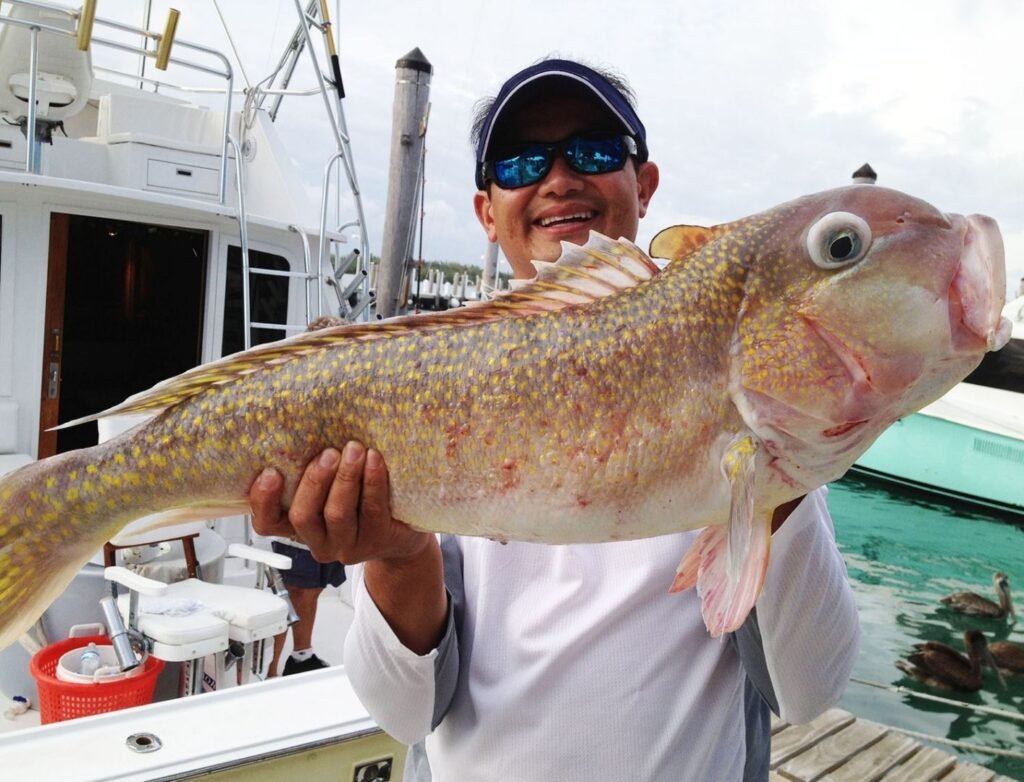Trophy Fish in Miami Beach: A Premier Destination for Anglers

Introduction Miami Beach, renowned for its beautiful coastline and vibrant marine life, stands as one of the premier destinations for anglers seeking to catch trophy fish. With its warm waters, diverse aquatic species, and professional Fishing Charters, Miami Beach offers an unparalleled fishing experience. Whether you’re a seasoned angler or a novice, the opportunity to reel in a trophy fish awaits. Why Miami Beach is a Top Destination for Trophy Fish Diverse Marine Ecosystem Miami Beach is situated in the heart of the Atlantic Ocean, providing access to a rich and diverse marine ecosystem. The warm Gulf Stream current brings a variety of large and exotic fish species close to shore. From mighty sailfish to elusive marlin, the waters around Miami Beach are teeming with trophy-worthy catches. Ideal Fishing Conditions The climate and sea conditions in Miami Beach are ideal for fishing throughout the year. The relatively stable weather and water temperatures ensure that fishing remains productive, and the local fishing guides are well-versed in navigating the best spots. Popular Trophy Fish Species in Miami Beach Sailfish Known for their impressive speed and agility, sailfish are a coveted prize for many anglers. Their striking appearance and thrilling fight make them a favorite among trophy hunters. Miami Beach’s waters are prime for catching these magnificent creatures, especially during the winter months. Marlin Blue and white marlins are among the most sought-after trophy fish. Their sheer size and strength provide an exhilarating challenge for even the most experienced anglers. Miami Beach offers some of the best marlin fishing opportunities, particularly in the summer and fall. Mahi-Mahi Also known as dolphin fish, mahi mahi are known for their vibrant colors and acrobatic leaps. They are a popular target for sport fishermen due to their delicious taste and exciting fight. Miami Beach’s waters are ideal for catching these stunning fish year-round. Tuna Yellow fin and black fin tuna are prized for their size and culinary value. Miami Beach provides excellent opportunities to catch these powerful fish, especially during the summer months when they migrate closer to shore. Best Times for Trophy Fishing in Miami Beach Seasonal Patterns Fishing for trophy fish in Miami Beach is often influenced by seasonal patterns. Sailfish and marlin are typically more active during the winter months, while mahi-mahi and tuna can be caught year-round. Understanding these patterns can enhance your chances of landing a trophy fish. Local Fishing Charters Partnering with a local fishing charter can greatly improve your chances of success. Experienced guides are familiar with the best times and locations for trophy fishing and can provide valuable insights and equipment. Charters often offer tailored experiences to target specific species. Tips for a Successful Trophy Fishing Experience Choose the Right Equipment Using the right gear is crucial for landing trophy fish. High-quality rods, reels, and bait can make a significant difference. Consult with local experts or your fishing charter to ensure you’re equipped for the challenge. Practice Your Techniques Effective fishing techniques vary by species. For example, trolling is commonly used for marlin, while live baiting is effective for sailfish. Practice and understanding of these techniques can improve your success rate. Respect Local Regulations Adhering to local fishing regulations helps preserve the marine environment and ensures sustainable fishing practices. Be aware of size limits, bag limits, and protected species to contribute to the health of Miami Beach’s waters. Conclusion Miami Beach is a premier destination for anglers seeking the thrill of catching trophy fish. With its diverse marine life, ideal fishing conditions, and professional charters, it offers an exceptional fishing experience. Whether you’re aiming for a sailfish, marlin, mahi-mahi, or tuna, Miami Beach provides the perfect backdrop for your next fishing adventure. Prepare your gear, book a charter, and get ready to reel in a trophy fish! FAQ: Trophy Fishing in Miami Beach What are the best times of year for catching trophy fish in Miami Beach? The best times to catch trophy fish in Miami Beach vary by species. Sailfish and marlin are most active from December to April, while mahi-mahi and tuna can be caught year-round. For the best results, consider booking a charter that specializes in your target species and consult with local experts about the current fishing conditions. Do I need a fishing license to fish for trophy fish in Miami Beach? Yes, you will need a fishing license to fish in Miami Beach. If you’re fishing from a charter boat, the license is typically included as part of the service. However, if you plan to fish from the shore or a private vessel, ensure you obtain the appropriate license from the Florida Fish and Wildlife Conservation Commission. What types of fishing charters are available in Miami Beach? Miami Beach offers various types of fishing charters, including half-day, full-day, and specialty trips. Charters may focus on specific types of fishing, such as Deep Sea Fishing for marlin or sailfish, or inshore fishing for species like mahi-mahi. Choose a charter based on your target species and the type of experience you’re seeking. What should I bring for a successful trophy fishing trip? For a successful trophy fishing trip, bring comfortable clothing suitable for the weather, sunscreen, a hat, and sunglasses. Most fishing charters provide all the necessary equipment, but you might want to bring your own fishing gear if you have specific preferences. It’s also a good idea to bring snacks, drinks, and a camera to capture your catch. How can I ensure a sustainable fishing experience? To ensure a sustainable fishing experience, follow local regulations regarding size limits, bag limits, and protected species. Practice catch and release when appropriate, and handle fish gently to minimize stress and injury. Supporting local conservation efforts and respecting the marine environment helps preserve Miami Beach’s rich fishing resources for future generations.
A Guide to Big Game Fishing: Catching Big Fish

Big game fishing, often referred to as offshore or Deep Sea Fishing, is a thrilling pursuit that pits anglers against some of the ocean’s most formidable creatures. The sport is not only about the size of the catch but also the entire experience – the chase, the fight, and the ultimate triumph. This comprehensive guide aims to provide you with all the information you need to embark on your Big Game Fishing adventure, from selecting the right gear to mastering the necessary techniques. Understanding Big Game Fishing Big game fishing targets large fish species such as marlin, tuna, swordfish, and sharks. These species inhabit deeper waters, far from the shore, which requires anglers to venture out into the open ocean. The challenge and excitement lie in the pursuit of these powerful fish, testing the angler’s skills and endurance. This type of fishing is not just about the catch but about the journey, the fight, and the satisfaction of a successful hunt. The Best Locations for Big Game Fishing The location is crucial in big game fishing, as different areas are known for specific species. Some of the top spots around the world include: Miami, Florida, USA: Miami is a vibrant fishing destination known for its abundance of sailfish, marlin, and tuna. The warm waters and diverse marine life make it a hotspot for big game fishing enthusiasts. Kona, Hawaii, USA: Kona’s calm waters and abundant marine life make it an ideal location for year-round big game fishing, with high chances of catching marlin and yellowfin tuna. Choosing the right spot involves considering the species you aim to catch, the best season for fishing in that area, and local regulations. Researching and consulting with local experts can significantly enhance your chances of a successful trip. Essential Gear for Big Game Fishing The right equipment is crucial for a successful big game fishing adventure. Given the size and power of the targeted species, your gear must be robust and reliable. Fishing Rods and Reels Investing in heavy-duty rods and high-capacity reels is essential. Heavy-duty rods are designed to withstand the immense strain that big game fish exert, while high-capacity reels can hold several hundred yards of heavy line, crucial for the long runs these fish often make. Lines and Leaders Braided lines are popular in big game fishing due to their strength and durability. Fluorocarbon leaders are also essential, providing abrasion resistance and being less visible to fish, increasing your chances of a successful hook-up. Terminal Tackle Your terminal tackle should include strong, sharp hooks – circle hooks are often recommended for big game fishing. Swivels and snap swivels are also crucial to prevent line twists and make it easier to change lures or rigs. Bait and Lures Live bait is commonly used in big game fishing, with mackerel, squid, and mullet being popular choices. Artificial lures, such as trolling lures, poppers, and jigs, mimic the movement of prey and can be highly effective. Techniques for Big Game Fishing Mastering various fishing techniques can significantly increase your chances of success in big game fishing. Trolling Trolling involves dragging lures or bait behind a moving boat, allowing you to cover large areas and locate fish. Outriggers are often used to spread lines and prevent tangling, creating a more effective fishing spread. Drifting Drifting allows your bait or lure to move naturally with the current. This technique is effective when fish are spread out over a large area and can increase your chances of attracting a bite. Kite Fishing Kite fishing keeps bait on the surface, creating an enticing presentation for surface-feeding predators like sailfish and marlin. This technique can be particularly effective in calm conditions and clear waters. Preparing for a Big Game Fishing Trip Preparation is key to a successful Big Game Fishing trip. This involves both physical and mental readiness, as well as ensuring you have all the necessary gear and safety equipment. Physical Preparation Big game fishing requires physical stamina and strength. Ensure you are in good shape and prepared for long hours on the water, as reeling in a big fish can be a strenuous activity. Mental Preparation Patience and focus are crucial in big game fishing. Long waits are often part of the experience, so staying mentally prepared and maintaining a positive attitude can make a significant difference. Safety Precautions Safety should always be a top priority. Wear life jackets at all times, carry emergency gear such as a first aid kit, flares, and a VHF radio, and always be aware of weather conditions to avoid getting caught in sudden storms. On the Day of the Trip The day of your big game fishing trip should start early to maximize your time on the water. Effective teamwork and clear communication are crucial, especially when dealing with a large catch. Early Start Starting your day early allows you to take advantage of the morning bite and gives you more time to locate and catch fish. Teamwork Big game fishing often requires a team effort. Assign roles and ensure everyone knows their responsibilities. Effective communication can make the difference between a successful catch and a missed opportunity. Keeping an Eye on the Fish Finder A fish finder can be invaluable for locating schools of fish and determining the best spots to fish. Regularly check the fish finder to adjust your strategy as needed. Catching and Handling Big Game Fish Once a fish takes the bait, the real challenge begins. Proper technique and handling are crucial to successfully catching and bringing the fish aboard. The Hook-Up When a fish takes the bait, it’s essential to set the hook firmly and maintain steady pressure to prevent the fish from escaping. Quick, decisive action is often required to secure the hook properly. The Fight Reeling in a big game fish can be a long and strenuous battle. Use your legs and back to avoid fatigue, and maintain a steady rhythm while reeling. Patience and endurance are key, as the fish will likely
